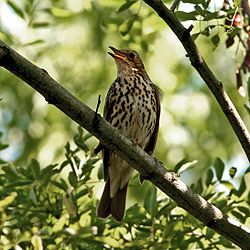Song thrush
| Song thrush | |
|---|---|
 |
|
| Singing in the Netherlands | |
| Scientific classification | |
| Kingdom: | Animalia |
| Phylum: | Chordata |
| Class: | Aves |
| Order: | Passeriformes |
| Family: | Turdidae |
| Genus: | Turdus |
| Species: | T. philomelos |
| Binomial name | |
|
Turdus philomelos Brehm, 1831 |
|
 |
|
| Global range Year-Round Range Summer Range Winter Range | |
The song thrush (Turdus philomelos) is a thrush that breeds across much of Eurasia. It has brown upperparts and black-spotted cream or buff underparts and has three recognised subspecies. Its distinctive song, which has repeated musical phrases, has frequently been referred to in poetry.
The song thrush breeds in forests, gardens and parks, and is partially migratory with many birds wintering in southern Europe, North Africa and the Middle East; it has also been introduced into New Zealand and Australia. Although it is not threatened globally, there have been serious population declines in parts of Europe, possibly due to changes in farming practices.
The song thrush builds a neat mud-lined cup nest in a bush or tree and lays four to five dark-spotted blue eggs. It is omnivorous and has the habit of using a favourite stone as an "anvil" on which to break open the shells of snails. Like other perching birds (passerines), it is affected by external and internal parasites and is vulnerable to predation by cats and birds of prey.
The song thrush was described by German ornithologist Christian Ludwig Brehm in 1831, and still bears its original scientific name, Turdus philomelos. The generic name, Turdus, is the Latin for thrush, and the specific epithet refers to a character in Greek mythology, Philomela, who had her tongue cut out, but was changed into a singing bird. Her name is derived from the Ancient Greek Φιλο philo- (loving), and μέλος melos (song). The dialect names throstle and mavis both mean thrush, being related to the German drossel and French mauvis respectively.Throstle dates back to at least the fourteenth century and was used by Chaucer in the Parliament of Fowls. Mavis is derived via Middle English mavys and Old French mauvis from Middle Breton milhuyt meaning "thrush." Mavis (Μαβής) can also mean "purple" in Greek.
...
Wikipedia

